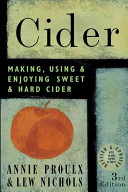Cider: making, using & enjoying sweet & hard cider

My series of reviews of cider making books wouldn’t be complete without covering the book you are most likely to find in your local homebrewing and wine making shop: Cider: making, using & enjoying sweet & hard cider by Annie Proulx1 and Lew Nichols. Last summer I read the 2nd edition, and this winter I read the 3rd edition for the review.
Cider begins with a good quick overview of the entire cider making process, then moves on to presses and growing apples. This book is definitely aimed at Canadians (and Americans) with their own apple orchards, not those of us stuck in cities. If you are interested in choosing which varieties of trees to plant in your northern USA or Canadian cider orchard, Cider appears to be an OK resource.
Compared to the other books, the authors are almost paranoid about Acetobacter; but this goes along with a long section on the production of apple cider vinegar. Interestingly, Proulx and Nichols warn against using windfall apples because of the potential presence of Acetobacter, but don’t mind the inclusion of a few worms. This is the opposite of the position taken in the other cider books, who are against worms and recommend the use of fresh and well-washed windfalls. Proulx and Nichols include nearly as much detail about the illegal production of applejack and apple brandy as of cider itself. An interesting note is the recommendation of using white wine yeasts instead of the champagne yeasts.
The third edition of Cider: making, using & enjoying sweet & hard cider is an improvement over the second, but Proulx’ and Nichols’ book still falls behind the other cider books. I found the constant switching between metric and English as the primary units to be distracting. There are also mistakes such as stating that the specific gravity of completely dry cider is 1.000. Because the density of ethanol is lower than that of water and the usual amount of residual sugar, dry ciders—including my own—have a finishing gravity below 1.000.
If you own or are planing on starting a cider orchard, Cider: making, using & enjoying sweet & hard cider is a decent book. Otherwise, I’d recommend one of the other books; preferably Andrew Lea’s Craft Cider Making or Simon McKie’s Making Craft Cider. For a quick introduction to cider making, read Andrew Lea’s website.
BibTeX records:
@book{proulx1997,
Author = {Annie Proulx and Lew Nichols},
Edition = {2nd},
Publisher = {Storey Communications},
Title = {Cider: making, using \& enjoying sweet \& hard cider},
Year = {1997}
}
@book{proulx2003,
Author = {Annie Proulx and Lew Nichols},
Edition = {3nd},
Publisher = {Storey Publishing},
Title = {Cider: making, using \& enjoying sweet \& hard cider},
Year = {2003}
}
Yes, the infamous fiction author. ↩